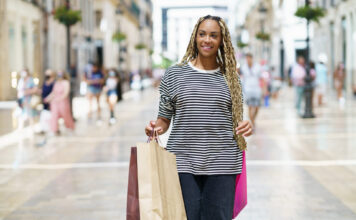When it comes to physical stores, retailers traditionally focus on the in-store journey. Customers enter, browse, trial then purchase. But the pandemic completely altered how people shop, with click and collect now the most frequently used shipping method in the UK.
Before he stepped down as CEO of Marks and Spencer, Steve Rowe announced the brand would be closing 32 city centre stores. Instead, it would be prioritising more modern edge-of-town sites, with better access and car parking – a key factor in convenient click and collect journeys. Starbucks is also moving away from its ‘third space’ approach to stores as a meeting place; pivoting the physical estate to focus on drive-through and pre-orders in 90% of new locations.

This does not indicate the looming death of physical retail though. Research by eMarketer in fact forecasts that bricks-and-mortar retail sales will grow between 2.6% and 3.4% by 2025.
It just means retailers need to adapt fast, to better reflect their store formats for how people shop today.
Box is a great example. Situated at the heart of Helsinki, it is a hassle-free self-service collection point where locals can retrieve packages they have ordered online. Designed to be the ‘perfect place to pick up a parcel’ it features recycling and packing, fitting rooms and lockers as well as a product showcase space. In addition, DPD has opened its first physical store in Germany. The ambition is to ‘turn the click and collect process on its head’. Here, as well as the ability to unpack and try on orders, customers also have access to fair trade coffee and organic snacks.
These behaviour shifts are universal post-pandemic and provide an untapped opportunity for leading retailers to move away from the tired, somewhat down-at-heel appearance of many collection points. Moving towards experiences that make the collection journey a joy, and ideally: tie into the wider brand experience.
Glossier’s London flagship is a brilliant example of this. Once decided on their beauty purchase in-store, shoppers can order online with the help of one of the in-store ‘editors’. The customer then heads for the collection point, where the products arrive in a Glossier gift bag on a theatrical conveyor belt creating an ‘instagrammable’ moment.
Plugging this overlooked piece in the customer journey is not only a chance to build loyalty, it makes financial sense too – online shoppers spend 23% more when choosing local pick-up or delivery and have a 25% higher basket size. Plus, 85% of consumers who have used BOPIS (Buy Online Pick up in Store) say that they have made additional unplanned in-store purchases when picking up an order placed online.
This is rapidly becoming a key area for brands to adapt and benefit from in the future. How can the click and collect moment of the retail experience become a point of difference, a moment of interaction and excitement, rather than being overlooked?
🏆
Creative Retail Awards - TICKETS NOW ON SALE!
19 September 2024, London
Join the excitement and prestige of the Creative Retail Awards, the ultimate celebration of innovation and excellence in retail, leisure and hospitality design, offering unparalleled opportunities for recognition, networking and celebration.
www.creativeretailawards.com















